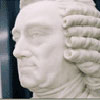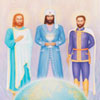Swedenborg And The Sweet Hereafter
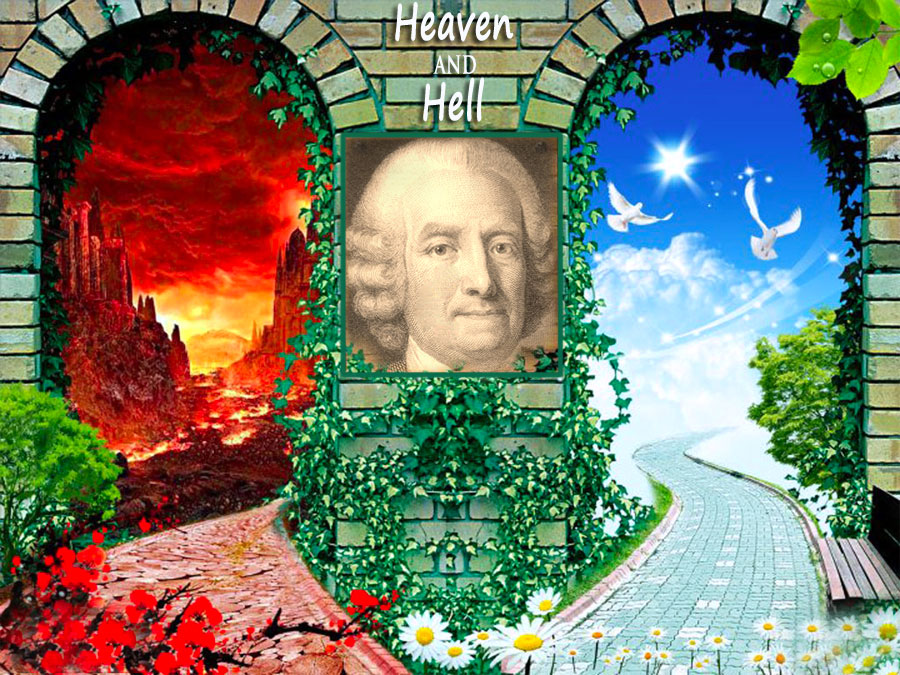 By Mark Harrison
By Mark Harrison
Taller than the others, this man
Walked among them, at a distance,
Now and then calling the angels
By their secret names. He would see
That which earthly eyes do not see:
The fierce geometry, the crystal
Labyrinth of God and the sordid
Milling of infernal delights.
He knew that Glory and Hell too
Are in your soul, with all their myths;
He knew, like the Greek, that the days
Of time are Eternity’s mirrors.
In unadorned Latin he went on listing
The unconditional Last Things.
(Poem by Jorge Luis Borges)
Emmanuel Swedenborg (1688-1772), son of a Lutheran Bishop and professor, was a respected scientist and practical engineer prior to his emergence as a philosopher whose primary concern was the spirit world. Before the publication of his first religious text, Worship and the Love of God, Swedenborg had published formative works on cosmology, anatomy, mineralogy and metaphysics as well as developing weapons and a system for the overland transportation of boats. At the age of 59, Swedenborg resigned his post as Special Assessor to the Royal College of Mines and retired to a life of contemplation, study and communion with the world of spirits. We see in the example of Swedenborg’s oeuvre, a simultaneity of science and the world of spirit rather than some clear split between. This overlap between science and metaphysics was more the rule than the exception up through the eighteenth century.
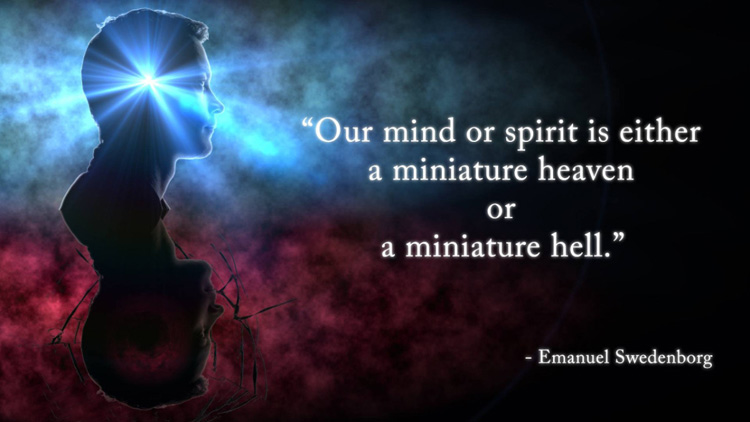 Swedenborg’s method of communication with residents of the other world was not always that of the trance medium – he sometimes entered into communion with his spiritual interlocutors in a fully conscious state – holding conversations with others present in the room while conversing with the spirits. “In the midst of company I have sometimes spoken with spirits and with those who were about me … At such times they could think no otherwise than that I was occupied with my own thoughts.” He would enter into a light trance state when transcribing the words of angels, which is how he consistently referred to the dead. For Swedenborg, there were no angels aside from humans who had passed on to the Other Side. This is a central element in the dynamic of demystification recurring throughout his works. The angels of Swedenborg, humans passed through to the Other side, stand in marked contrast to the terrible beings of Milton and the Old Testament. Most of Swedenborg’s writings were prepared in this state of light trance. Swedenborg had cultivated the ability to pass into a trance state through shallow breathing starting with his boyhood practice of holding his breath during morning and evening prayers: “My respiration was so formed by the Lord that I could respire inwardly for a considerable time without the aid of external air … in order that I may be with spirits and speak with them.” “When heaven was opened to me and I was able to converse with spirits, I sometimes scarcely breathed by inspiration at all and merely drew in enough air to keep Brown, up the process of thinking”.
Swedenborg’s method of communication with residents of the other world was not always that of the trance medium – he sometimes entered into communion with his spiritual interlocutors in a fully conscious state – holding conversations with others present in the room while conversing with the spirits. “In the midst of company I have sometimes spoken with spirits and with those who were about me … At such times they could think no otherwise than that I was occupied with my own thoughts.” He would enter into a light trance state when transcribing the words of angels, which is how he consistently referred to the dead. For Swedenborg, there were no angels aside from humans who had passed on to the Other Side. This is a central element in the dynamic of demystification recurring throughout his works. The angels of Swedenborg, humans passed through to the Other side, stand in marked contrast to the terrible beings of Milton and the Old Testament. Most of Swedenborg’s writings were prepared in this state of light trance. Swedenborg had cultivated the ability to pass into a trance state through shallow breathing starting with his boyhood practice of holding his breath during morning and evening prayers: “My respiration was so formed by the Lord that I could respire inwardly for a considerable time without the aid of external air … in order that I may be with spirits and speak with them.” “When heaven was opened to me and I was able to converse with spirits, I sometimes scarcely breathed by inspiration at all and merely drew in enough air to keep Brown, up the process of thinking”.
Swedenborg did not simply speak with the spirits but was taken by them to other planes of existence and to other planets (the latter travels being recorded most notably in a treatise with the typically ungainly eighteenth century title – Concerning Earths in the Solar World, Which Are Called Planets; and Concerning Earths in the Starry Heavens; and Concerning Their Inhabitants; and Likewise Concerning the Spirits and Angels 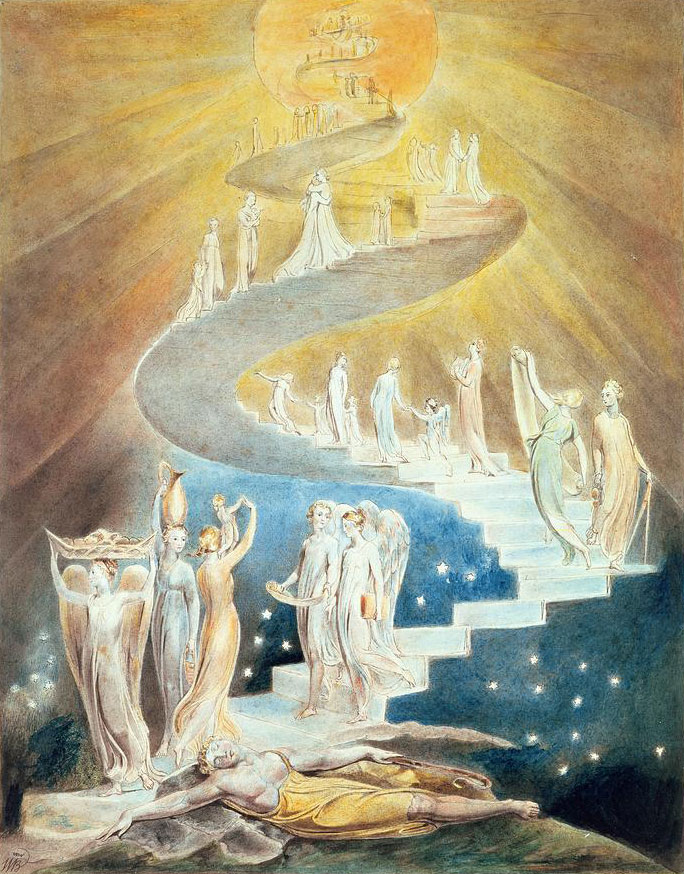 There from Things Seen and Heard). During his travels, Swedenborg was to gather the knowledge which he would expound upon through thousands of pages of Latin prose – prose which profoundly influenced a variety of movements and individuals (including Baudelaire, Coleridge, Emerson, Blake, Henry James and C.S. Pierce). On these journeys in which he not merely spoke with spirits but moved among them, Swedenborg would enter into a deeper trance state, sometimes for days at a time. The messages Swedenborg returned with are centrally concerned with the potential redemption of humanity and its forward movement toward a utopian society. Swedenborg’s works appeared in the midst of a century heavily populated by narratives of the “fantastic voyage.” Such narratives used the conceit of a journey to some remote land to set up a comparison wherein the traveler’s homeland is held up against some discovered ideal society. Swedenborg departs from this tradition in that his utopian ideals are ostensibly drawn not from his imagination but from the worlds that in “fact” exist beyond our own—a precedent repeated throughout the various moments detailed within these pages, displacing imagination and faith with direct observation.
There from Things Seen and Heard). During his travels, Swedenborg was to gather the knowledge which he would expound upon through thousands of pages of Latin prose – prose which profoundly influenced a variety of movements and individuals (including Baudelaire, Coleridge, Emerson, Blake, Henry James and C.S. Pierce). On these journeys in which he not merely spoke with spirits but moved among them, Swedenborg would enter into a deeper trance state, sometimes for days at a time. The messages Swedenborg returned with are centrally concerned with the potential redemption of humanity and its forward movement toward a utopian society. Swedenborg’s works appeared in the midst of a century heavily populated by narratives of the “fantastic voyage.” Such narratives used the conceit of a journey to some remote land to set up a comparison wherein the traveler’s homeland is held up against some discovered ideal society. Swedenborg departs from this tradition in that his utopian ideals are ostensibly drawn not from his imagination but from the worlds that in “fact” exist beyond our own—a precedent repeated throughout the various moments detailed within these pages, displacing imagination and faith with direct observation.
Central to Swedenborgian doctrine was the assertion that humans were created to exist simultaneously on the spiritual and material planes, a conception central to Spiritualist belief. While many, if not most, humans had lost their ability to recognize and articulate their existence on the spiritual plane, this did not change the fundamental 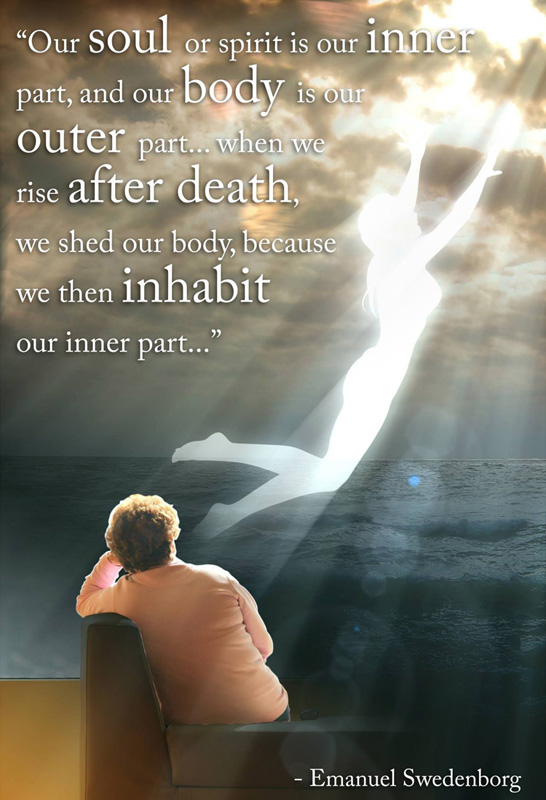 fact that the two levels of existence were and are inextricably intertwined and recursive. Swedenborg’s goal was to establish ongoing communication between terrestrial and spiritual existence, a goal abetted in part by his contention that the step from one to the other was not so precipitous as was generally understood. Humans changed very little in their passage from this world to the next. Within heaven one found houses, communities and governments. One encountered people going about their day-to-day business. The first plane of the afterlife was so similar to earth that decedents often found it hard to believe that they were dead. Swedenborg’s philosophy also accounted for a hell. Once entering the vestibular area that comprised the first phase of life after death, each of the dearly departed was called upon to assess his or her own character and then assign themselves to heaven or hell, a rational procedure versus becoming subject to the judgment of an all-knowing God. As in the Swedenborgian heaven, hell constituted a sort of extension of earthly existence, where one was free to pursue whatever vices one had cultivated previously with the sole caveat that if a resident’s licentiousness exceeded that which she had practiced on earth, she was subject to a beating from her fellow hellions. Upon entering the afterlife, one continued to strive toward perfection, unless you had chosen hell, in which case perfection was out of question. The heaven one passed into after death was but the first of seven. The seventh heaven consisted of absorption into God. Thus the spirit of progress continued on after death, a conceit with clear appeal to practitioners of nineteenth century Spiritualism in America, and dovetailing neatly with other narratives of progress such as Social Darwinism and Manifest Destiny, narratives with the utmost faith in an inevitable historical progress toward perfection. That faith in coming perfection was extended to the spiritual as well as material world. “There is a march of progress in spiritual unfolding.” Communication with the dead would come to be understood in the context of Spiritualism as evidence of that progress.
fact that the two levels of existence were and are inextricably intertwined and recursive. Swedenborg’s goal was to establish ongoing communication between terrestrial and spiritual existence, a goal abetted in part by his contention that the step from one to the other was not so precipitous as was generally understood. Humans changed very little in their passage from this world to the next. Within heaven one found houses, communities and governments. One encountered people going about their day-to-day business. The first plane of the afterlife was so similar to earth that decedents often found it hard to believe that they were dead. Swedenborg’s philosophy also accounted for a hell. Once entering the vestibular area that comprised the first phase of life after death, each of the dearly departed was called upon to assess his or her own character and then assign themselves to heaven or hell, a rational procedure versus becoming subject to the judgment of an all-knowing God. As in the Swedenborgian heaven, hell constituted a sort of extension of earthly existence, where one was free to pursue whatever vices one had cultivated previously with the sole caveat that if a resident’s licentiousness exceeded that which she had practiced on earth, she was subject to a beating from her fellow hellions. Upon entering the afterlife, one continued to strive toward perfection, unless you had chosen hell, in which case perfection was out of question. The heaven one passed into after death was but the first of seven. The seventh heaven consisted of absorption into God. Thus the spirit of progress continued on after death, a conceit with clear appeal to practitioners of nineteenth century Spiritualism in America, and dovetailing neatly with other narratives of progress such as Social Darwinism and Manifest Destiny, narratives with the utmost faith in an inevitable historical progress toward perfection. That faith in coming perfection was extended to the spiritual as well as material world. “There is a march of progress in spiritual unfolding.” Communication with the dead would come to be understood in the context of Spiritualism as evidence of that progress.
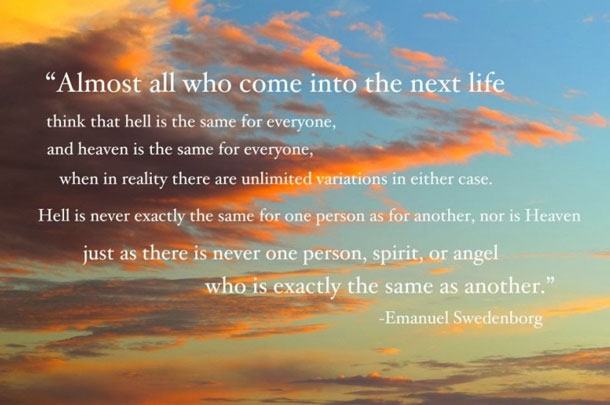 Swedenborg occupied a central place in the pantheon of Spiritualism. As Sir Arthur Conan Doyle put it in the first volume of his History of Spiritualism (a document which, as rumor – and irony – would have it, was largely ghost-written) “In point of fact, every spiritualist should honour Swedenborg, and his bust should be in every Spiritualist temple, as being the first and greatest of modern mediums.” John Humphrey Noyes, founder of the Oneida Colony, went so far as to call Spiritualism “Swedenborgianism americanized.” Swedenborg’s role in Spiritualism is explained in part by his capacity as medium and his claim to the knowledge that humanity did in fact persist after death and was eager to communicate information about the nature and status of the afterlife. In addition to exhibiting the ability to commune with the dead, a key “higher phenomenon,” Swedenborg was also famed for his “traveling clairvoyance.” As well as traveling throughout the solar system and the halls of heaven, he was also known to extend his consciousness across terrestrial space. A particularly celebrated case, which was related by philosopher Immanuel Kant, involved the Stockholm fire of 1759. While attending a dinner in Göteborg, Swedenborg several times retired to the garden returning with reports of the fire that was taking place some 280 miles away. This is one among many stories illustrating the seer’s ostensible abilities in “remote viewing.”
Swedenborg occupied a central place in the pantheon of Spiritualism. As Sir Arthur Conan Doyle put it in the first volume of his History of Spiritualism (a document which, as rumor – and irony – would have it, was largely ghost-written) “In point of fact, every spiritualist should honour Swedenborg, and his bust should be in every Spiritualist temple, as being the first and greatest of modern mediums.” John Humphrey Noyes, founder of the Oneida Colony, went so far as to call Spiritualism “Swedenborgianism americanized.” Swedenborg’s role in Spiritualism is explained in part by his capacity as medium and his claim to the knowledge that humanity did in fact persist after death and was eager to communicate information about the nature and status of the afterlife. In addition to exhibiting the ability to commune with the dead, a key “higher phenomenon,” Swedenborg was also famed for his “traveling clairvoyance.” As well as traveling throughout the solar system and the halls of heaven, he was also known to extend his consciousness across terrestrial space. A particularly celebrated case, which was related by philosopher Immanuel Kant, involved the Stockholm fire of 1759. While attending a dinner in Göteborg, Swedenborg several times retired to the garden returning with reports of the fire that was taking place some 280 miles away. This is one among many stories illustrating the seer’s ostensible abilities in “remote viewing.”
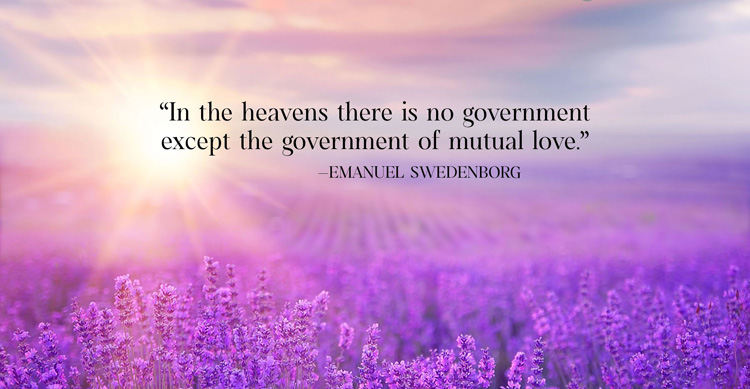 Swedenborg thus established, via his practice and writings, some of the basic tenets of Spiritualism. The first of these was that the world of the living and the world thereafter were always already in communication and that such communication rightly constituted a central concern of spiritual practice. To access said communication, one had merely too enter into a trance state. This trance state allowed not only for communication with spiritual entities but also for astral travel and a heightened capacity for healing. The trance state as received via Swedenborg and mesmeric practice, especially in its implications of passivity, was to be of central importance to Spiritualism as well as to the variants of human-alien communication that followed in its wake. To commune with the world of Spirit one had to open oneself to it—a fundamentally feminine posture. A further element of Swedenborg’s philosophy that would centrally inform Spiritualism was his rather homely vision of Heaven. The sense that the dead maintained much of their humanity in their heavenly existence did much to demystify and desanctify traditional ideas of the afterlife—an integral dynamic in the crafting of a “new” enchantment for a rational age. It also minimized the gap between humanity’s current state and its hoped for perfection. Angels residing in the utopian afterlife were wholly recognizable and comprehensible in Swedenborg’s scheme. “After the dissolution of the body, a man’s spirit appears in the spiritual world in the human form altogether as in the natural world.” This sense of the dead’s humanity closed the gap between this world and the next, putting one in communication with the other. Swedenborg bypassed God in his explorations of the afterlife. His line of communication led directly to the dead, or as he called them, the angels. Unlike prayer, a unidirectional mode of communication, with no promise of return, Swedenborg’s inquiries were subject to the receipt of direct reply—a shift that anticipated the replacement of the uncertainty of written correspondence and its twin displacements of time and space with the near and actual simultaneity of telegraphy and telephony. This strong sense of the close continuity of life and life after death and the familiarity of the dead, the immediacy of the exchange between living and dead and the fact that one could readily recognize oneself in the dead’s comportment, would be both key to Spiritualism’s popular success and instrumental in its demise. All the aforementioned traits also contributed to aligning the world of spirit and the world of the observable.
Swedenborg thus established, via his practice and writings, some of the basic tenets of Spiritualism. The first of these was that the world of the living and the world thereafter were always already in communication and that such communication rightly constituted a central concern of spiritual practice. To access said communication, one had merely too enter into a trance state. This trance state allowed not only for communication with spiritual entities but also for astral travel and a heightened capacity for healing. The trance state as received via Swedenborg and mesmeric practice, especially in its implications of passivity, was to be of central importance to Spiritualism as well as to the variants of human-alien communication that followed in its wake. To commune with the world of Spirit one had to open oneself to it—a fundamentally feminine posture. A further element of Swedenborg’s philosophy that would centrally inform Spiritualism was his rather homely vision of Heaven. The sense that the dead maintained much of their humanity in their heavenly existence did much to demystify and desanctify traditional ideas of the afterlife—an integral dynamic in the crafting of a “new” enchantment for a rational age. It also minimized the gap between humanity’s current state and its hoped for perfection. Angels residing in the utopian afterlife were wholly recognizable and comprehensible in Swedenborg’s scheme. “After the dissolution of the body, a man’s spirit appears in the spiritual world in the human form altogether as in the natural world.” This sense of the dead’s humanity closed the gap between this world and the next, putting one in communication with the other. Swedenborg bypassed God in his explorations of the afterlife. His line of communication led directly to the dead, or as he called them, the angels. Unlike prayer, a unidirectional mode of communication, with no promise of return, Swedenborg’s inquiries were subject to the receipt of direct reply—a shift that anticipated the replacement of the uncertainty of written correspondence and its twin displacements of time and space with the near and actual simultaneity of telegraphy and telephony. This strong sense of the close continuity of life and life after death and the familiarity of the dead, the immediacy of the exchange between living and dead and the fact that one could readily recognize oneself in the dead’s comportment, would be both key to Spiritualism’s popular success and instrumental in its demise. All the aforementioned traits also contributed to aligning the world of spirit and the world of the observable.
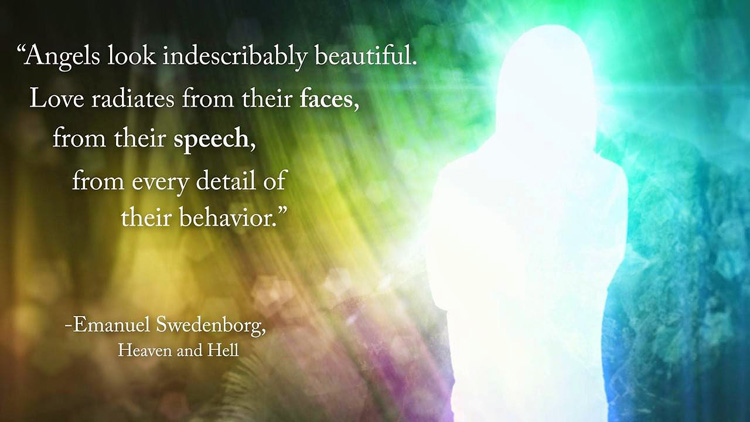 Furthermore, Swedenborg’s status as a man of science, his presentation of his findings in ponderous Latin prose and the quotidian nature of his descriptions of the afterlife all lent a patina of scientific respectability to his spectral perambulations. His assessment of the afterlife was based not upon faith, or wisdom received by holy writ, but rather via experimentation, direct observation and experience—all aligning with sound empirical practice. In this sense, Swedenborg’s was a Modern faith and constituted an early moment of neo-enchantment. The sense that Swedenborg’s researches were a form of natural science was carried through into Mesmerism and Spiritualism and was key in how the latter practices were understood as in keeping with their time rather than wholly as anachronisms.
Furthermore, Swedenborg’s status as a man of science, his presentation of his findings in ponderous Latin prose and the quotidian nature of his descriptions of the afterlife all lent a patina of scientific respectability to his spectral perambulations. His assessment of the afterlife was based not upon faith, or wisdom received by holy writ, but rather via experimentation, direct observation and experience—all aligning with sound empirical practice. In this sense, Swedenborg’s was a Modern faith and constituted an early moment of neo-enchantment. The sense that Swedenborg’s researches were a form of natural science was carried through into Mesmerism and Spiritualism and was key in how the latter practices were understood as in keeping with their time rather than wholly as anachronisms.
Francis Bacon foresaw the gradual victory of observation and experiment–the triumph of actual analysed fact—in every department of human study;—in every department save one. The realm of ‘Divine things’ he left to Authority and Faith. I here urge that that great exemption need no longer be made. I claim that there now exists an incipient method of getting this Divine knowledge also, with the same certainty, the same calm assurance, with which we make our steady progress in the knowledge of terrene things. The authority of creeds and Churches will thus be replaced by the authority of observation and experiment. The impulse of faith will resolve itself into a reasoned and resolute imagination, bent upon raising even higher than now the highest ideals of man.
The religious concerns of Mesmerism, Swedenborgianism and Spiritualism were understood not as supernatural but as part of the progressive revelation of the natural world to human understanding. The Swede’s writings and its consequents promised nothing less than a rational comprehension of the Spirit.
Free pdf e-books by Swedenborg can be obtained through the video link in the description.
Posted in Life On Other Worlds, Life On The Other Sidewith comments disabled.




